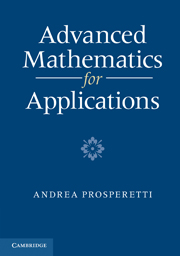Book contents
- Frontmatter
- Contents
- Preface
- To the reader
- List of tables
- Part 0 General Remarks and Basic Concepts
- Part I Applications
- Part II Essential Tools
- 8 Sequences and Series
- 9 Fourier Series: Theory
- 10 The Fourier and Hankel Transforms
- 11 The Laplace Transform
- 12 The Bessel Equation
- 13 The Legendre Equation
- 14 Spherical Harmonics
- 15 Green's Functions: Ordinary Differential Equations
- 16 Green's Functions: Partial Differential Equations
- 17 Analytic Functions
- 18 Matrices and Finite-Dimensional Linear Spaces
- Part III Some Advanced Tools
- Appendix
- References
- Index
15 - Green's Functions: Ordinary Differential Equations
Published online by Cambridge University Press: 05 June 2012
- Frontmatter
- Contents
- Preface
- To the reader
- List of tables
- Part 0 General Remarks and Basic Concepts
- Part I Applications
- Part II Essential Tools
- 8 Sequences and Series
- 9 Fourier Series: Theory
- 10 The Fourier and Hankel Transforms
- 11 The Laplace Transform
- 12 The Bessel Equation
- 13 The Legendre Equation
- 14 Spherical Harmonics
- 15 Green's Functions: Ordinary Differential Equations
- 16 Green's Functions: Partial Differential Equations
- 17 Analytic Functions
- 18 Matrices and Finite-Dimensional Linear Spaces
- Part III Some Advanced Tools
- Appendix
- References
- Index
Summary
Green's functions permit us to express the solution of a non-homogeneous linear problem in terms of an integral operator of which they are the kernel. We have already presented in simple terms this idea in §2.4. We now give a more detailed theory with applications mainly to ordinary differential equations. The next chapter deals with Green's functions for partial differential equations.
The determination of a Green's function requires the solution of a problem similar to (although somewhat simpler than) the original one, but the effort required is balanced by several advantages. In the first place, and at the most superficial level, once the Green's function G is known, it is unnecessary to solve the problem ex novo for every new set of data: it is sufficient to allow G to act on the new data to have the solution directly. Secondly, and most importantly for our purposes, Green's function theory provides a foundation for the various eigenfunction expansion and integral transform methods used in Part I of this book. Thirdly, even if the Green's function cannot be determined explicitly, one can base on it the powerful boundary integral numerical method outlined in §16.1.3 of the next chapter. Furthermore, once an expression for the solution of a problem – even if not fully explicit – is available, it becomes possible to deduce several important features of it, including bounds existence, uniqueness and others.
Information
- Type
- Chapter
- Information
- Advanced Mathematics for Applications , pp. 348 - 399Publisher: Cambridge University PressPrint publication year: 2011
